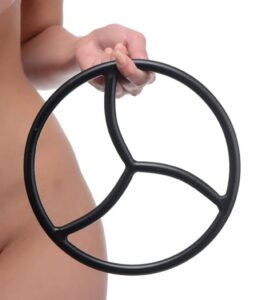Hello, my lonely random reader, today we will talk about what we directly use for suspension. So, we’ve made a point, but what comes next?
Let’s start with bamboo.


I like bamboo the most, especially if it’s thick, around 120 mm in diameter or more; it’s reliable and convenient to work with. However, finding such a thick piece can be difficult, while 60-70 mm is more realistic to locate.
Even with small cracks, it easily supports me (weighing 120 kg). It’s much more reliable than wood. Lightweight too. The only thing it fears is moisture, which can cause it to crack. However, bamboo with a cross-section of 120 mm can tolerate almost any crack. Additionally, bamboo has an extremely important advantage: it doesn’t wear down the rope. In short, I highly recommend it.
Next, let’s discuss rings, or rather three types of rings.
Starting with a smooth metal ring.

This option is my least favorite. The problem is that the rope, especially in suspensions, tends to snag. Once, I was asked to help remove a snagged rope while the rigger held the bottom partner in their arms. Another downside is that it’s really slippery, meaning it doesn’t forgive mistakes—if the suspension rope slips from your hands, there’s a high chance your partner will end up on the floor. This type of ring works almost like a pulley, and yes, the rope begins to wear down due to its smaller diameter.
On the plus side, it is reliable if well-made, lightweight, and doesn’t take up much space.
Now, the gymnastic ring.

I prefer this option over the metal one. It forgives some mistakes since there’s more friction due to its larger diameter, which means the rope suffers less. If you buy a properly certified gymnastic ring, it’s very reliable.
The rope tends to snag even more than on the metal ring because of the increased friction.
Then there’s this type of ring.

I’ve worked with these a couple of times and didn’t quite understand their purpose. I apologize in advance to the artisans who make them. My opinion might not be accurate. The downsides are the same as with a regular metal ring.
Another general downside of rings is that they limit movement in suspension quite a bit because of their shape.
In conclusion: they’re reliable, easy to transport, and serve as a decent portable point. That’s how I’ve used rings.

Carabiners and Swivels.
When I first entered the world of large rope bondage, it was possible to have a set of carabiners, strictly climbing ones, along with a climbing swivel. This set is still with me today.

Carabiners are the least favorite of all the items I’ve mentioned. Their only advantage is predictable reliability; they have a defined load limit known since purchase, and it will be exactly as stated.
Everything else is purely downside. In the end, I only kept carabiners for use on cuffs, which I use for spanking.
The swivel—I’ve only used it about five or six times in my entire practice. Yes, the suspension and rotation of the bottom partner look impressive on stage, but it’s not needed for anything else.
Rope. I’ve seen work done with rope loops a few times. In my opinion, it’s unreliable, firstly due to the rope itself. Secondly, because of excessive friction. Thirdly, it’s easy to get tangled in the process.
This option only works if there’s no other choice. I don’t like it, but it is possible.
That’s about it.
In summary.
Rope bondage is great primarily because a person who is reasonably skilled with rope doesn’t need anything else. They can create a suspension point from the rope on practically any vertical surface.
But if we’re being honest:
For home, for studio, or in general for some stationary point, I believe there’s nothing more reliable and interesting than bamboo.
If you need a portable option, securely connect a gymnastic ring and a carabiner in any way. This setup can be easily transported.
That’s all for now. Next time, we’ll talk about the rope itself.

